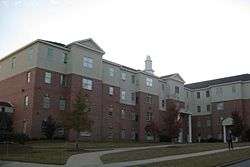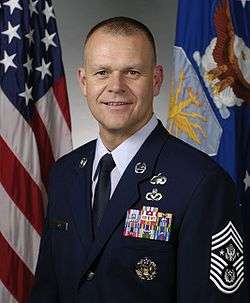Troy University
 | |
Former names |
Troy Normal School (1887–1929) Troy State Teachers College (1929–1957) Troy State College (1957–1967) Troy State University (1967–2005)[1] |
|---|---|
| Motto | "Educate the mind to think, the heart to feel, and the body to act." |
| Type | Public |
| Established | 1887 |
Academic affiliations | ACHE, SACS |
| Endowment | $85.53 million[2] |
| Chancellor | Jack Hawkins, Jr. |
| Vice-Chancellor | Earl Ingram |
| Students | 19,579[3] |
| Location | Troy, Alabama, U.S. |
| Campus | Rural, 650 acres (1.9 km²) [4] |
| Colors |
Cardinal, Silver, Black |
| Nickname | Trojans |
| Mascot | T-Roy |
Sporting affiliations | NCAA Division I – FBS, SBC |
| Website |
www |
 | |
Troy University is a comprehensive public university that is located in Troy, Alabama, United States. It was founded on February 26, 1887 as Troy State Normal School within the Alabama State University System by an Act of the Alabama Legislature. It is the flagship university of the Troy University System with its main campus enrollment of 6,998 students and the total enrollment of all Troy University campuses of 19,579.[5] Troy University is regionally accredited by the Southern Association of Colleges and Schools Commission on Colleges (SACS) to award associate, baccalaureate, master's, education specialist, and doctoral degrees.[6][7]
In August 2005, Troy State University, Montgomery; Troy State University, Phenix City; Troy State University, Dothan; and Troy State University (Main Campus) all merged under one accreditation to become Troy University to better reflect the institution's worldwide mission. Prior to the merger, each campus was independently accredited and merging of these campuses helped to create a stronger institution by eliminating overlapping services and barriers to students. The merger combined talents and resources of staff, faculty, and administrators into a single highly effective and competitive university.
Today, the University serves the educational needs of students in four Alabama campuses, sixty teaching sites in 17 U.S. States and 11 countries. Troy University's graduates number more than 100,000 alumni representing all 50 states and from numerous foreign countries. Troy University is known as Alabama's International University for its extensive international program in attracting foreign students from around the world.
History
Troy University is a public university with its main campus located in Troy, Alabama. It was founded as a normal school in 1887 with a mission to educate and train new teachers. The school has since evolved into a state university, located in four sites across the State of Alabama: Troy, Montgomery, Phenix City and Dothan. The university also has various sites located throughout the United States and several international locations. Troy University is known for its innovation in offering in-class and online academic programs in servicing traditional, nontraditional, and military students. The main campus enrollment as of the fall of 2014 is 6,998 students. The campus itself consists of 36 major buildings on 650 acres (1.9 km²) plus the adjacent Troy University Arboretum. [edit]
At least three prominent political figures have been associated with Troy University. George Wallace, Jr., son of the late Governor George C. Wallace, is a former administrator at the university. Max Rafferty, the California Superintendent of Public Instruction from 1963 to 1971, was dean of the education department from 1971 until his death in 1982. Former Governor John Malcolm Patterson, an intra-party rival of George Wallace, taught U.S. history at the institution during the 1980s.
Name change
On April 16, 2004, the Board of Trustees voted to change the name of the institution from Troy State University to Troy University. The transition to the new name was completed in August 2005 and was the fifth in the school's history. When created by the Alabama Legislature on February 26, 1887, it was officially named the Troy State Normal School. The school was located in downtown Troy until moving to the present location on University Avenue in 1930. In 1929, the name was changed to Troy State Teachers College and it subsequently conferred its first baccalaureate degree in 1931. In 1957, the legislature voted both to change the name to Troy State College and to allow it to begin a master's degree program. The name was changed once again in 1967 to Troy State University.
Academics
Structure
Troy University cumulatively offers 46 bachelor's degree programs, 22 master's degree programs, and 2 doctoral program with an overall selective acceptance rate of 68%.
The University is composed of:
- Five Colleges
- The Graduate School
- The Division of General Studies
Rankings
| University rankings | |
|---|---|
| National | |
| Forbes[8] | 648 |
| Regional | |
| U.S. News & World Report[9] | 65 (South) |
| Master's University class | |
| Washington Monthly[10] | 424 |
Troy University has acquired different institutional rankings from various sources:
- Forbes Magazine ranks Troy as the 648th best school in the nation. Forbes’ overall ranking centers on the value of the degree obtained by a university’s students and measures, in part, the marketplace success of a school’s graduate.
- U.S. News & World Report in several categories for 2016:
- Regional Universities (South) - 65th
- Top Public Schools (South) - 27th
- Best Grad School for Rehabilitation Counseling - 82nd
- Best Online Graduate Nursing Programs - 91st[11]
- For the seventh year in a row, the Princeton Review named Troy to its “Best in the Southeast” list due to excellence in academic programs and institutional data collected from the university.[12]
- In 2008, Troy University was ranked as the 25th best university in the United States for international students by the Institute of International Education.
Campus

Troy University's Troy campus is located near downtown Troy. The campus sits along rolling hills with many old oak trees present along the streets and throughout campus. A very small lake named Lake Lagoona sits in front of university's Sorrell Chapel.
The university closed the Trojan Oaks Golf Course in order to build a new basketball arena, but remnants of the course are still present and are utilized freely for practice.

Student life


Students who live on campus at Troy have a choice of 12 halls. University Apartments (for married students/students with children) is located a few blocks from campus.
Recreation
There are many recreational activities available on campus. The Trojan Fitness Center offers fitness machines, free weights, and cardiovascular machines. Trojan Games is a recreation room has two billiard tables, two table tennis tables, and a foosball game. The Natatorium houses an eight-lane 25-yard Olympic style pool. The Recreation Center Gym has two basketball courts, cardio room, a dance room, and a large outside pool. Wright Hall Gym, located adjacent from the Natatorium, offers a basketball court, two volleyball courts, and four badminton courts. The Intramural Fields consist of four flag football fields, two softball fields, and one soccer field.
Trojan Arena, the newest facility on campus is the home to the basketball, volleyball, and track programs as well as being used for the University's commencement ceremonies and other special events with seating capacity of 6,000. The new Trojan Arena replaces the University's longtime basketball and events facility, Sartain Hall, which opened in 1962.
Trojan Arena is equipped with 5,600 chair-back seats and several VIP suites and boxes. Under the main court sits 10,000 sq. ft. of basketball practice space. Beyond the normal concession area is a food court style lounge and a simulated court area on the concourse that heightens the Trojan fanatic experience. The Trojan Arena includes seven upper-level suites and an exclusive Stadium Club area for donors, while also adding floor seating for students. Among the latest technology features of the new arena is a three-tiered rotunda at the main entrance, an interior concourse with concession stands, and a food court-styled dining center with various specialty food items. It features an LED ribbon board that panoramically encircles the entire arena with two 767-square-foot video boards that enhances the total sports gaming experience; the only one of its kind in the Sun Belt Conference. The Trojan Arena is also home to the Troy University Sports Hall of Fame with digital displays of its honored members located adjacent to the rotunda.
Transportation
The Troy University Transportation Service offers students free shuttling services at various stops across campus and within the surrounding community.
Greek life
There are 21 traditional Greek organizations on Troy's campus.
| IFC Fraternities[13] | Alpha Tau Omega (AΤΩ) | Delta Kappa Epsilon (ΔKE)[14] | Delta Chi (ΔΧ) | Lambda Chi Alpha (ΛXA) | Tau Kappa Epsilon (TKE) | FarmHouse (FH) | Pi Kappa Phi (ΠΚΦ) | Sigma Chi (ΣΧ) |
|---|---|---|---|---|---|---|---|---|
| NPC Sororities[15] | Alpha Gamma Delta (AΓΔ) | Alpha Delta Pi (AΔΠ) | Chi Omega (ΧΩ) | Phi Mu (ΦM) | Kappa Delta (KΔ) | |||
| NPHC Greek Life[16] | Alpha Kappa Alpha (AKA) | Zeta Phi Beta (ZΦB) | Delta Sigma Theta (ΔΣθ) | Phi Beta Sigma (ФВΣ) | Sigma Gamma Rho (ΣΓΡ) | Omega Psi Phi (ΩΨΦ) | Kappa Alpha Psi (ΚΑΨ) | Alpha Phi Alpha (ΑΦΑ) |
Religious and other organizations
The university is home to numerous religious campus organizations such as: Gamma Phi Delta Christian Fraternity, The Campus Awakening, Chi Alpha, Wesley Foundation, Baptist Campus Ministries, Pentecostal Campus Ministries, The Newman Center (Roman Catholic), The Christian Student Center (Church of Christ), and The Troy Secular Association. Some of these religious organizations have stand-alone physical facilities on the Troy campus.

Music organizations
There are six music organizations that function under the supervision of the John M. Long School of Music:[17]
- Phi Mu Alpha
- Kappa Kappa Psi
- Sigma Alpha Iota
- Tau Beta Sigma
- Phi Boota Roota
- CMENC, a student affiliate of the National Association for Music Education
Student media
The school newspaper, the Tropolitan (commonly referred to as "The Trop"), is located on the bottom floor of Wallace Hall. It is a weekly publication, written and produced entirely by students. The Palladium, is located in adjacent offices in the same building. Also located in Wallace Hall is Troy University Television, also referred to as Troy TrojanVision. Troy University Television broadcasts three live entirely student produced newscasts twice daily. TrojanVision Global News, TrojanVision Midday & TrojanVision Nightly News. Troy TrojanVision also produces a 30-minute sports show, Trojan Sports Now, every week. TrojanVision streams live online and can be seen at the university's YouTube page.
The "Sound of the South" marching band
Music is an integral part of Troy University as it boasts 29 faculty members in the School of Music. With over 200 undergraduate music majors and fields with a variety of music ensembles including: a Symphonic Band, two Concert Bands, two Jazz Bands, a Trumpet Ensemble, Pep Band, Brass Quintet, and more. The school of music also hosts a Brass Symposium every spring semester.
Athletics

Troy State Normal School began its sports program in 1909 when it fielded its first football team. Through the early years Troy's athletics nicknames were not official and varied by the sport and the coach. Eventually teams all began to use the name "Troy State Teachers," but when the athletic teams moved into NAIA competition the nickname was then was changed to the "Red Wave". In the early 1970s the student body voted to change the name to Trojans after many felt that Red Wave was too similar to the University of Alabama's nickname, the Crimson Tide. Prior to becoming a member of NCAA Division I athletics in 1993, Troy University was a member of the Gulf South Conference of the NCAA Division II ranks. Troy's primary rivals were Jacksonville State University, Livingston University (now the University of West Alabama), and the University of North Alabama. In 2004, Troy joined the Sun Belt Conference of the Football Bowl Subdivision.

Football
Troy University began playing football in 1909. The program has won three national championships, the NAIA national football championship in 1968 and the NCAA Division II national football championship in 1984 and 1987. Troy transitioned to the NCAA's Division I-A in 2001, became a football only member of the Sun Belt Conference in 2004, and joined the conference for all other sports in 2005. In 2001, Troy defeated Mississippi State at Scott Field in Starkville, Mississippi, by a score of 21–9 which was the Trojans' first victory over a BCS level program. In 2004, the Trojans defeated a ranked BCS program for the first time ever, defeating #17 Missouri 24-14 at home on ESPN2. The Trojan football team made its first bowl game appearance in the Silicon Valley Football Classic on December 30, 2004, but lost to Northern Illinois, 34–21. In 2006, Troy won the Sun Belt Conference for the first time after defeating Middle Tennessee State toward the end of the 2006 season. Troy represented the Sun Belt Conference in the 2006 New Orleans Bowl as the conference champion for the first time where the Trojans defeated the Rice Owls of Conference USA by a score of 41–17. Troy has most recently participated in the 2010 New Orleans Bowl where the Trojans routed Ohio by a score of 48–21. Former Troy football head coach Larry Blakeney served 25 seasons as head coach between 1990 and the end of the 2014 season. He has led the program to three Southland Football Conference titles and five Sun Belt Conference titles, as well as guided the Trojans to seven FCS playoff appearances and five FBS bowl games. Blakeney boasts an overall record of 178–113–1 as head coach at Troy. Blakeney is the winningest coach in the Troy University history and he is the 4th winningest collegiate coach all-time in the state of Alabama, only behind greats Paul "Bear" Bryant, Cleve Abbott, and Ralph "Shug" Jordan. Blakeney is one of two coaches in college football history to be the head coach of a football program during its transition from Division II to I-A (the other being UCF’s Gene McDowell). The current head coach is Neal Brown.
Basketball
The Troy University men's basketball team was under the direction of head coach Don Maestri for 31 years until his retirement in 2013. Coach Maestri is the winningest coach in school history, with exactly 500 career wins, and he has won numerous conference coach-of-the-year awards during his tenure at Troy University. The program has won 11 conference championships in basketball, with six of them coming in the Division I era. On January 12, 1992, Troy defeated DeVry University of Atlanta by the score of 258–141, in what is the highest scoring game in college basketball history. The Trojans competed in the 2003 NCAA Tournament in Nashville against Xavier University after winning the Atlantic Sun Conference title. In 2004, Troy was an NIT participant in a match-up against Niagara University. In 2008, coach Maestri was inducted into the Wiregrass Sports Hall of Fame at a ceremony in Dothan, Alabama. In 2009, the Trojans finished 3rd place in the Sun Belt Conference and competed in the CBI against College of Charleston. After winning the Sun Belt regular season title in 2010, the Trojans would be invited to play in the NIT once again against Ole Miss. Maestri is a member of the Troy University Sports Hall of Fame.
Maestri was replaced by Phil Cunningham on March 26, 2013.[18]
The Troy University women's basketball team is currently under the direction of head coach Chanda Rigby, a junior college standout and coaching veteran.
Baseball
The Troy University baseball team won two Division II national championships in 1986 and 1987 under the leadership of coach Chase Riddle. One of Troy's biggest victories in baseball came in April 1998 when the Trojans knocked off the #3 nationally ranked University of Alabama Crimson Tide by a score of 8–4 at Riddle-Pace Field on the Troy campus. Under the direction of current head coach Bobby Pierce, the Trojan baseball program has competed in the NCAA Baseball Tournament in 2006 and 2007. Troy also competed in the 1995 and 1997 NCAA Division One tournament under head coach John Mayotte. In 1999, the program tying the NCAA Division I record for most hits in the 6th inning, belting 14 hits (in the 6th) in a 34–4 rout of Stetson.[19]
Rodeo
The program's governing body is the National Intercollegiate Rodeo Association. The rodeo program's home facility is the Pike County Cattlemen's Arena in Troy where it hosts a three-day rodeo each October that features college rodeo programs from throughout the southern region of the United States. Troy University calf roper Ben Mayworth won the 2007 national title in Casper, Wyoming, at the National Finals Collegiate Rodeo.
Campus and academic features

Hall of Fame of Distinguished Band Conductors
The Hall of Fame of Distinguished Band Conductors was established on the campus of what was then known as Troy State University in Troy, Alabama by the National Band Association in 1979. The Hall of Fame contains the picture and biographies of band directors who have distinguished themselves in some way or who have made significant contributions to the field of band directing, conducting, or leadership.

Confucius Institute
The Confucius Institute is a non-profit public institute that aims at promoting Chinese language and culture while supporting local Chinese teachings through international affiliated Confucius Institutes. Its headquarters is in Beijing and is under the Office of Chinese Language Council International or Hanban. The first Confucius Institute in the state of Alabama opened at Troy University in the fall of 2008.
The Manuel H. Johnson Center for Political Economy
Troy University’s Manuel H. Johnson Center for Political Economy was formed in September as the result of a $3.6 million gift from Troy alumnus Dr. Manuel H. Johnson, BB&T and the Charles G. Koch Charitable Foundation. The Center’s mission is the advancement of free market economic ideas and its research and teaching efforts explore the idea that economic freedom improves the quality of life for citizens. The new Center is part of the University’s Sorrell College of Business and it is housed inside Bibb Graves Hall. Dr. Scott Beaulier serves as the center’s executive director.
University libraries
The libraries on the Dothan, Montgomery, and Troy campuses house collections of more than 500,000 bound volumes, 40,000 media items, and nearly 1 million items in microform. The Troy University Library on the Troy campus is a Federal Depository Library.
Notable alumni
Cory Cooper Implementation Analyst Specialist
 Mike Rivera, 1997
Mike Rivera, 1997 William G. Gregory, 1984
William G. Gregory, 1984 Manuel H. Johnson, 1973
Manuel H. Johnson, 1973 Kevin R. Kregel, 1988
Kevin R. Kregel, 1988- DeMarcus Ware, 2005
 Osi Umenyiora, 2003
Osi Umenyiora, 2003 Lawrence Tynes, 2001
Lawrence Tynes, 2001 James A. Roy, 2000
James A. Roy, 2000 Leodis McKelvin, 2008
Leodis McKelvin, 2008 Windham Rotunda (aka Bray Wyatt), attended
Windham Rotunda (aka Bray Wyatt), attended Marshall B. Webb, 1994
Marshall B. Webb, 1994
References
- ↑ Songe, Alice. American Universities and Colleges: A Dictionary of Name Changes. Scarecrow Press (Metuchen, NJ: 1978), p. 213
- ↑ As of June 30, 2015. "U.S. and Canadian Institutions Listed by Fiscal Year (FY) 2015 Endowment Market Value and Change in Endowment Market Value from FY 2014 to FY 2015" (PDF). National Association of College and University Business Officers and Commonfund Institute. 2016.
- ↑ Unduplicated Headcount Report, Oct. 20, 2014
- ↑ "Troy University | Troy | Troy Events at wsfa.com". Events.wsfa.com. September 10, 2011. Archived from the original on March 31, 2012. Retrieved 2012-01-26.
- ↑ Unduplicated Headcount Report, Oct. 20, 2014
- ↑ Troy University Graduate School Troy University. 2007-2013. Retrieved February 5, 2013
- ↑ Doctor of Nursing Practice (DNP) Troy University. 2007-2013. Retrieved February 5, 2013
- ↑ "America's Top Colleges". Forbes. July 5, 2016.
- ↑ "Best Colleges 2017: Regional Universities Rankings". U.S. News & World Report. September 12, 2016.
- ↑ "2016 Rankings - National Universities - Masters". Washington Monthly. Retrieved September 6, 2016.
- ↑ "Troy University". US News Best College Rankings 2016. Retrieved September 9, 2015.
- ↑ "2016 Best Southeastern Universities". Princeton Review. Retrieved September 9, 2015.
- ↑ Interfraternity Council
- ↑ "Delta Kappa Epsilon International Fraternity Website by ChapterSpot.com". Dke.org. November 11, 2011. Archived from the original on November 14, 2012. Retrieved 2012-01-26.
- ↑ College Panhellenic Council
- ↑ National Pan-Hellenic Council
- ↑ "Troy University "Sound of the South"". Soundofthesouth.org. Retrieved 2014-08-11.
- ↑
- ↑ http://fs.ncaa.org/Docs/stats/baseball_RB/2012/D1.pdf
External links
| Wikimedia Commons has media related to Troy University. |
Coordinates: 31°47′53″N 85°57′14″W / 31.79806°N 85.95389°W